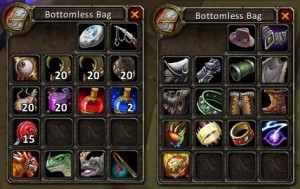Rarely should the DM intentionally design an encounters that can’t be beat. However, there are times when the DM finds it necessary. I am not stating that all encounters should be designed as a player killers or deliberate total party kill encounters. Nor am I talking about introducing a villain that the characters will fight in ten levels, only to have them attack him at first level. This series explores the reasons behind why the DM might feels it’s necessary to design an encounter that can’t be beat and how to pull it off.
Tag: D&D
Month in Review: February 2011
In February we celebrated our second anniversary. For the specifics on how we’re doing be sure to check out the State Of The Dungeon – Year 2. As we move into our third great year here at Dungeon’s Master we continue bringing you exciting 4e D&D articles every day.
Our weekly coverage of D&D Encounters continues as we see the program move from season three to season four. In February we provided more articles for DMs and players, with a special focus on role-playing. We also revisited Eberron in February, and looking at skill challenges we came up with a way to make them even more exciting. If you missed any of our great articles from February this is your chance to get caught up.
We’d also like to take this opportunity to thank the readers who visited us throughout February. By visiting Dungeon’s Master every day, and leaving your feedback in the comments section, you’ve let us know that we’re doing a good job. Thank you.
Blurring the Line Between Encounters
Generally the definition of what constitutes an encounter is not something that is up for debate. During an encounter the PCs engage a bunch of monsters, perform a skill challenge, or some combination of the two. When the encounter is over the PCs have the opportunity to take a short, 5-minute rest after which they regain encounter powers, heal wounds by expending healing surges and move one step closer to achieving a milestone.
In a recent game we ran into a situation where this standard definition of encounter was questioned. As the DM I choose to make a few calls on the fly to keep the action moving. Afterwards the group spent a lot of time discussing whether or not we handled the situation correctly. The intent was not to critique the DM or the calls made at the time; rather we wanted to lay some groundwork just in case we ever found ourselves in a similar situation again.
After describing the situation to a few other DMs, I learned that our situation was not as unique as we thought and a lot of other groups had experienced similar circumstances themselves. As it turned out, no one was sure what the correct course of action was. Knowing that this situation might occur again at our table and that it may happen at your table (if it hasn’t already) I’m putting this conundrum to you, our readers. I’ll explain what happened and how we handled the situation. I’m looking for you input and feedback on our rulings.
My Love Affair With Minions
 It started innocently enough. At first just one and then another. Before I knew it minions had invaded my encounters. It was so easy to just add one more. I’ve considered counselling to help me deal with my problem. The last encounter I ran my players through had 23 minions in it. I’m afraid I’ve gone too far. I’m not sure I can reconcile my love affair with minions.
It started innocently enough. At first just one and then another. Before I knew it minions had invaded my encounters. It was so easy to just add one more. I’ve considered counselling to help me deal with my problem. The last encounter I ran my players through had 23 minions in it. I’m afraid I’ve gone too far. I’m not sure I can reconcile my love affair with minions.
I worry my players may hold the excess amount of minions they face against me. That they may grow bored with encounters as they realize that they have less and less cause to roll damage dice. Worse, I fear they all may recreate their characters and come back as controllers.
 The morning began with a difficult river crossing followed by an unexpected goblin ambush in the woods. With any luck the heroes might actually reach the ruins of Castle Inverness without any other mishaps or violence. This week’s encounter began at dusk, just as the caravan spotted the ruins of Castle Inverness in the distance.
The morning began with a difficult river crossing followed by an unexpected goblin ambush in the woods. With any luck the heroes might actually reach the ruins of Castle Inverness without any other mishaps or violence. This week’s encounter began at dusk, just as the caravan spotted the ruins of Castle Inverness in the distance.
Brother Splintershield, the leader of the new community, called the caravan to a halt. He beckoned the adventurers to come forth along with Malgram and his scouts. Splintershield and his acolytes are planning to perform a ritual on the site of the castle ruins. This will consecrate the ground, protecting it from evil. But before he can begin, he wants to make sure things are safe.
Malgram and his Rangers agree to search the perimeter. Splintershield asks the PCs to check the actual ruins. They look abandoned from here, but better safe than sorry. The party, this week consisting of Belgos (the Dragonborn), Jarren, Keira, Valenae, a Battlemind and another Rogue, agreed to check it out.
The Living Spells of Eberron
 The Mournland is one of the great mysteries of the Eberron campaign setting. It was created by some arcane accident that will never be explained. One of its more intriguing elements are the living spells that now haunt the land. Representing the spells being cast at the time of the Mourning, these spells gained some semblance of sentience and attack when the opportunity is presented.
The Mournland is one of the great mysteries of the Eberron campaign setting. It was created by some arcane accident that will never be explained. One of its more intriguing elements are the living spells that now haunt the land. Representing the spells being cast at the time of the Mourning, these spells gained some semblance of sentience and attack when the opportunity is presented.
Eberron is the campaign setting that the Dungeon’s Master team uses for our home game. During a recent stint of encounters the party was investigating strange disturbances that mirrored the effects of the Mournland. In an attempt to keep the party off balance and provide them with a new challenge, some some new Living Spells were created.
Rarely in D&D do we keep track of where our character is wounded. When he gets hit we just record damage and move on. In order for combat to run smoothly this is a compromise we’ve accepted from day one. Until you PC falls below 0 hit points you just assume he’s got full control over his entire body.
Last week I broke my arm and it got me thinking about how to introduce a system into 4e D&D that represented damage to specific areas of the body. The real trick was to do it in a way that actually added value to the game without just slowing things down or adding unnecessary new rules.
The way I see it, tracking specific damage can be handled in one of two ways: 1) strictly from a role-play perspective; or 2) as an actual mechanic that affects the numbers.
 As an adventurer you discover all kinds of interesting items. Some of the items are mundane and others magical. The most obvious items are your weapon and armour. As you advance, your helm, glove, boots and cloak are all replaced by magical items that you have discovered. Eventually a point of saturation is reached and the only way to increase your power level is by gaining the next version of your current item. Advancing your magic weapon from +1 to +2 and so forth.
As an adventurer you discover all kinds of interesting items. Some of the items are mundane and others magical. The most obvious items are your weapon and armour. As you advance, your helm, glove, boots and cloak are all replaced by magical items that you have discovered. Eventually a point of saturation is reached and the only way to increase your power level is by gaining the next version of your current item. Advancing your magic weapon from +1 to +2 and so forth.
As your character advances in level wealth continues to accumulate and there is the ability to find or purchase additional magic items. Many of these items are consumables, but are still worth obtaining. I am a fan of items that require healing surges to power them. Especially for those defenders who have more healing surges than they could ever likely spend during the normal course of adventuring.
Last week’s eventful river crossing gave the party a chance to work together for the first time. Overall they worked well as a team. No one died (except the stirges) and the only wounds the party received were inconsequential scrapes and bruises. The party’s success was noted by Malgram, the Ranger in charge of leading Brother Splintershield and the settlers to the ruins of Castle Inverness.
A few hours after the river crossing, Malgram and an as yet unknown female Elf approached the PCs. Malgram introduces the PCs to Faldyra. She is an historian who plans to chronicle the efforts of the settlers as they rebuild on the castle’s ruins. She’s also got a green thumb and wishes to collect various plants, herbs, and roots in the surrounding area.
Malgram asks the PCs if they will accompany Faldyra into the nearby forest and keep an eye on her while she gathers the various plants she seeks. He was impressed by the party’s combat abilities and is sure that they could handle any potential dangers that lurk in the woods (not that he believes there is anything to worry about).
Faldyra, already heading off on her own, waves to the party as she get farther away from the caravan. It’s pretty clear that she’s going whether she’s got chaperones of not. The party quickly catches up to her and agrees to watch out for her well-being.
Have you ever wondered how NPCs interpret your character’s level? Do they look at you any differently when you’re level 3 then when you’re level 8? What about when you reach paragon tier?
Just because your PC has earned enough XP to advance a couple of levels doesn’t necessarily mean that the world will look at you any differently. But as you continue to gain additional levels you should eventually start to distinguish yourself from other adventurers.
Your level represents a wide variety of things about your character. It’s tied directly to the amount of XP you’ve earned, or in other words the deeds you’ve accomplished. It also reflects the amount of wealth and material goods you’ve accumulated. And don’t forget that as you earn levels you’ll acquire power and influences in social and political circles.
Based on these criteria, I’ve taken a stab at drawing parallels between D&D character level and the career successes of famous Hollywood movie stars. I’ve put together a list of some of today’s most famous and popular stars and tried to rank them according to their corresponding D&D level.